
Roebling Suspension Bridge
Marker Number 1601:
First bridge to span Ohio River, connecting Kentucky and Ohio. John Augustus Roebling, engineer; Amos Shinkle, president of Covington-Cincinnati Bridge Co. The formal opening of this bridge was celebrated, January 1, 1867. A prototype for famed Brooklyn Bridge, the Suspension Bridge remained open during tragic flood of 1937. Listed on National Register of Historic Places, 1975.

This is a daunting post. Not only because the John A. Roebling Bridge (formerly the Cincinnati-Covington Bridge) has so much history I could possibly cover but also because I like it so much. It is one of my favorite bridges ever and not only because I have some Shinkles in my family tree.
I love how it looks with a Covington backdrop. I love how it looks with a Cincinnati backdrop.
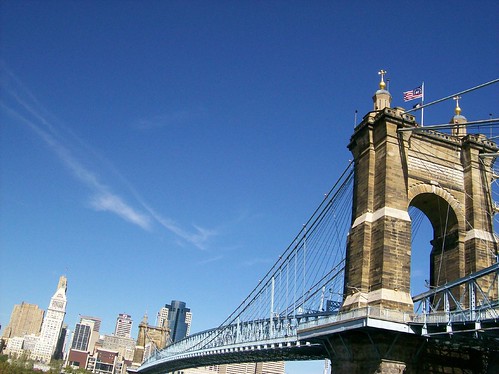
I love the sound it makes when your car drives over it. I love the sound it makes when other people's cars drive over it.
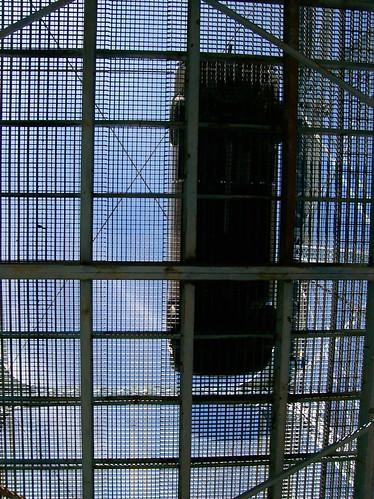
I could discuss the father and son Roebling bridge building team. I could write about the changes the bridge face do to the increase of automobile traffic. I could expand upon about it's change from a toll to a free bridge. I could even spend a good amount of time telling about it receiving it's much overdue paint job. You thought watching paint dry was boring well just wait until I blog about it, hehe.
There was almost so much I could possibly talk about that I almost put this marker on the back burner for when I had some more free time. However, knowing Callie will be posting about her river boat cruise commemorating the 1937 flood, I felt I could not wait. I mean, this bridge was one of the few things that stayed open during that devastating flood.
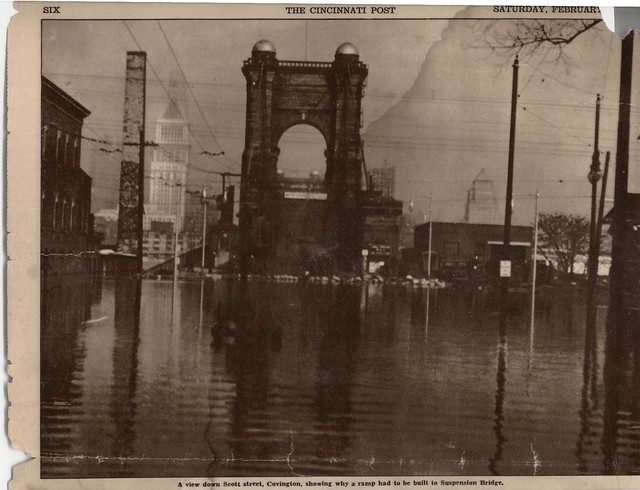
Also, it was one of the few historical markers that are related to the flood in any way. I could see in the future this will probably change. I am surprised the flood itself does not have a historical marker somewhere in Northern Kentucky. (After writing that sentence I posted that thought on the Kenton County Historical Society facebook page.)
I will now try to briefly summarize (this will be tough) the history of the Roebling Suspension bridge.
The bridge almost did not happen. The Ohio River was definitely a deterrent in commerce traffic between Kentucky and Ohio. These being the days when the government did not simply buy everything to fix such problems, a solution not only had to be reached, it also had to bring about a possible profit.
As early as February of 1846, a serious solution to this problem was sought. That was when the Covington and Cincinnati Bridge Company was formed.
 The Company faced many setbacks such as steamboat and ferry petitions and a bridge collapse. But when hope for a bridge seemed almost lost, a wealthy and successful Covington businessman was elected to the board of trustees by the name of Amos Shinkle. Amos Shinkle was, in his own way, the key...stone (get it?) to the bridge finally getting under way.
The Company faced many setbacks such as steamboat and ferry petitions and a bridge collapse. But when hope for a bridge seemed almost lost, a wealthy and successful Covington businessman was elected to the board of trustees by the name of Amos Shinkle. Amos Shinkle was, in his own way, the key...stone (get it?) to the bridge finally getting under way.Reputable bridge builder John Augustus Roebling was contacted and plans were drawn up for the first ever bridge to span the Ohio river. He worked on it along with his son Washington Lilian Roebling. Construction began in September of 1856. It would be slow going until its final completion in late 1866.
Surprisingly, the Civil War helped the bridge as much as it hurt it. A permanent way to cross the Ohio river would help the Union transfer material to build defenses in Kentucky, and soon money from investors came pouring in. Nothing like a threat of invasion to expand one's pockets. Unfortunately though, most of the work force was tied up, shooting with each other or at each other.
Construction of the bridge began in earnest after the war and little over a year and a half after the south surrendered at Appamattox, the first person crossed the bridge on Dec. 1, 1866.
Roebling ended up using over one millions pounds of wire (10,360 wires shipped from Manchester, England), 11 ton anchors were embedded in each block, and 600,000 feet of oak lumber were laid as the floor across 300 wrought iron suspended beams.
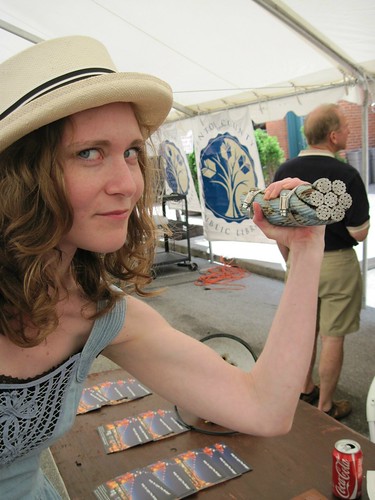
Who's tougher? Becky or the wire?
A few factoids about the bridge:
- It was brown then changed to blue (as it remains today).
- It has been expanded in about every direction possible. Its original design for mainly foot and cart traffic had to be changed for street cars and then the automobile.
- It even, as previously mentioned, survived the worse flood this are has ever seen since it has been populated, the great flood of 1937.
- It began as a toll bridge operated by The Covington-Cincinnati Bridge Company and remained so until 1953 when the Commonwealth of Kentucky purchased it.
- It was known as the "Covington-Cincinnati Suspension Bridge," until it was renamed "John A. Roebling Suspension Bridge" on June 27, 1983.
- Upon completion, it was the longest suspension bridge in the world.
- The Roeblings took much of what they learned and applied it to their most famous work, the Brooklyn Bridge.
 |
Today the John A. Roebling bridge is still well traveled and well loved. Thanks to many preservation efforts, the bridge looks about as good today as it did back when the very first person crossed.
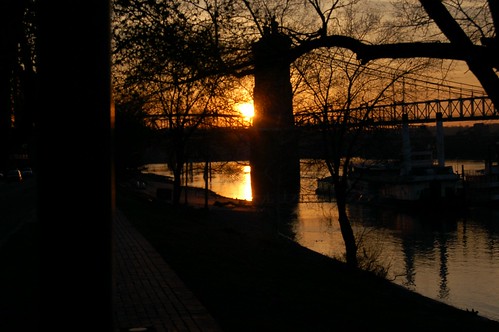
Looking great for a 146 year old. You just know it must of had some work done.

A poem about a slightly more famous bridge, but still sort of related. I sometimes think of this poem when I cross bridges. http://www.poets.org/viewmedia.php/prmMID/15444
ReplyDeleteI just read the poem. A nice thing to think of when crossing a bridge. Well as long as you do not think too much about the poet jumping from a boat and killing himself. Should have been a bridge.
DeleteI like the way my steering wheels shakes when I drive across it.
ReplyDeleteI also have good memories of going to Reds games with my dad when I was a kid. We'd park in Covington, then walk across the Suspension Bridge. I'm lucky I now get to do that with my children.
Very true about the steering wheel.
DeleteMy family would also always park in Covington and walk across for a game. I am glad you have continued the tradition.
My grandma always told me my great great great grandpa worked on the bridge. And we always called it the "Singing Bridge." So there you go...
ReplyDeleteWhat was your great great great gandpa's name? Investigate! Heh.
DeleteI like the "Singing Bridge" as a nickname.
Ahhh...the longest suspension bridge in the world. The Roebling Suspension Bridge spans over 1,057 feet (322 m). Today, many pedestrians use this bridge to get between the arenas in Cincinnati like Paul Brown Stadium, Great American Ball Park, and U.S. Bank Arena. I'm glad that all the efforts of the people, including John A. Roebling himself, of course, who worked for this project, have paid off.
ReplyDeleteAlphonse Daigle
This comment has been removed by a blog administrator.
ReplyDelete